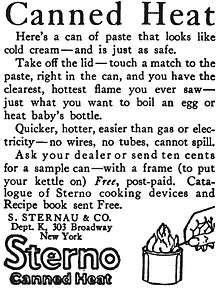Sterno

Sterno ("canned heat") is a fuel made from denatured and jellied alcohol. It is designed to be burned directly from its can. Its primary uses are in the food service industry for buffet heating and in the home for fondue and as a chafing fuel for heating chafing dishes. Other uses are for camp stoves and as an emergency heat source. It is also a popular fuel for use with toy and model steam and other external combustion engines. Sterno cans were sometimes taken on trips and used to heat curling irons and hot combs for hairstyling, for use when travelers were not near salons providing these services.
History

The Sterno brand and trademark is owned by Sterno Products, a portfolio company of Westar Capital LLC based in Corona, California.[1] The brand was purchased from Blyth, Inc. in late 2012.[2] Blyth had acquired the business from Colgate-Palmolive in 1997.[3]
The name comes from that of the original manufacturer, S. Sternau & Co. of Brooklyn, New York, a maker of chafing dishes, coffee percolators and other similar appliances since 1893. It had previously applied the name to its "Sterno-Inferno" alcohol burner. In 1918, it promoted its Sterno Stove as being a perfect gift for a soldier going overseas.[4] In his book With the Old Breed, E. B. Sledge describes its use on the battlefields of the Pacific Theatre in 1944 and 1945.
Invented around 1900, Sterno is made from ethanol, methanol, water and an amphoteric oxide gelling agent, plus a dye that gives it a characteristic pink color. The methanol is added to denature the product, which is intended to make it too toxic for consumption. Designed to be odorless, a 7 oz (198 g) can will burn for up to two hours.[5] It was discovered while producing nitrocellulose during the manufacturing process.
Nitrocellulose is a material used in manufacturing explosives and is made by combining shredded wood pulp and adding a nitric sulfuric acid mix. A by-product of the manufacturing process produces a gel-like substance later refined as Sterno.
In 2007, NASCAR owner/driver Michael Waltrip and his team had severe penalties handed down by officials. Team Vice-President Bobby Kennedy and Crew Chief David Hyder of Waltrip's No. 55 were ejected from the Daytona International Speedway. Hyder was fined $100,000 for his involvement with lining fuel tanks and intake valves with Sterno. NASCAR also docked Waltrip 100 owner points and disqualified his qualifying speed for the Daytona 500. Mid-week, NASCAR determined that the then unknown substance was Sterno. When the highly regulated NASCAR fuel was added, the Sterno would liquefy, giving the car an added octane boost.[6]
As a drink
There are many instances of people drinking Sterno to become intoxicated, i.e. as a form of surrogate alcohol. Since the alcohol it contains is denatured, Sterno is poisonous. Bluesman Tommy Johnson alludes to the practice in his song Canned Heat Blues recorded in 1928.[7] The blues band Canned Heat derived their name from the practice.
The practice is said to have become popular during Prohibition[8] and during the Great Depression in hobo camps, or "jungles", when the Sterno would be squeezed through cheesecloth or a sock and the resulting liquid mixed with fruit juice to make "jungle juice," "sock wine," or "squeeze".[9]
The 1956 American documentary On the Bowery includes footage of three homeless men straining Sterno cooking fuel to make "squeeze" and then drinking the alcohol.[10]
In an article for the Journal of the American Medical Association in 1961, Capt. James H. Shinaberger, MC, writes about a study of three people who had suffered methanol poisoning as a result of drinking Sterno. One of the patients "had been drinking Sterno for about a week and had been in the city prison for 48 hours when severe abdominal pain and vomiting occurred".[11]
In December 1963, a rash of 31 deaths in Philadelphia's homeless population was traced to a local store that knowingly sold Sterno to people for them to consume and get drunk.[12]
See also
References
- ↑ "The Sterno Group LLC". insideview.com]. Retrieved 27 November 2012.
- ↑ "Blyth, Inc. Announces Sale Of Sterno Business (Press release)". Bloomberg. PR Newswire. 29 October 2012. Retrieved 10 June 2014.
- ↑ "Company News; Colgate To Sell Heating Fuel Business For $70 Million". The New York Times. 2 October 1997. Retrieved 11 February 2015.
- ↑ "Image 6 of The New York Times, August 25, 1918". The Library of Congress. Retrieved 2018-02-04.
- ↑ "Sterno CandleLamp 7 oz. Odorless Canned Heat (6-Pack)-20503 - The Home Depot". The Home Depot. Retrieved 2018-02-04.
- ↑ Coble, Don (February 12, 2007). "Waltrip could face a Sterno penalty". The Florida Times-Union.
[...] inspectors found a gel-like coating inside the manifold. Several engine builders from other teams said the substance appeared to be Sterno, a bluish gel that could provide a hotter, cleaner burn inside the engine to create more horsepower.
- ↑ National Park Service, Trail of the Hellhound: Tommy Johnson Accessed on 10/09/11
- ↑ in google books
- ↑ "Police Start Drive on Drinkers of Canned Heat", The Sarasota Journal, January 5, 1962.
- ↑ "On The Bowery" Turner Classic Movies
- ↑ Shinaberger, J. H. (1961). "Treatment of Methanol Poisoning by Extracorporeal Dialysis". Archives of Internal Medicine. 108 (6): 937–939. doi:10.1001/archinte.1961.03620120121016.
- ↑ "Commonwealth of Pennsylvania v. Max Feinberg (1967) 433 Pa. 558, 253 A.2d 636".